
Hartlepool is a seaside and port town in County Durham, England. It is governed by a unitary authority borough named after the town. The borough is part of the devolved Tees Valley area. With an estimated population of 92,600, it is the second-largest settlement in County Durham.

West Hartlepool was a predecessor of Hartlepool, County Durham, England. It developed in the Victorian era and took the name from its western position in the parish of what is now known as the Headland.

Tees Valley is a combined authority area in North East England, around the lower River Tees. The area is not a geographical valley; the local term for the valley is Teesdale. The combined authority covers five council areas: Darlington, Hartlepool, Middlesbrough, Redcar and Cleveland and Stockton-on-Tees.
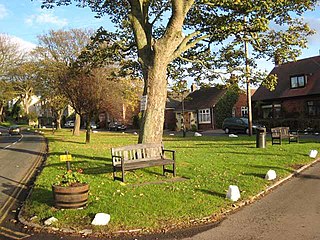
Elwick is a village and civil parish in the borough of Hartlepool in County Durham, England. It is situated near the A19 road to the west of Hartlepool. Historically, Elwick was a township until 1866 when it became a civil parish.

The Borough of Hartlepool is a local government district with borough status in County Durham, England. Since 1996 Hartlepool Borough Council has been a unitary authority, being a district council which also performs the functions of a county council; it is independent from Durham County Council. It is named after its largest settlement, Hartlepool, where the council is based. The borough also includes a rural area to the west of the town. The population of the borough at the 2021 census was 92,571, of which over 95% (87,995) lived in the built-up area of Hartlepool itself.

The County Borough of Teesside was a county borough in the north-east of England, which existed for just six years. It was created in 1968 to cover the Teesside conurbation which had grown up around the various port and industrial towns near the mouth of the River Tees. The council was based in Middlesbrough, the area's largest town. The county borough was abolished in 1974 on the creation of the new county of Cleveland, which covered a larger area, with the county borough's territory being split between three of the four districts created in the new county. In 1971 it had a population of 396,233.

Stockton-on-Tees Town Hall is a municipal building in the High Street in Stockton-on-Tees, County Durham, England. The building, which is the meeting place of Stockton-on-Tees Borough Council, is a Grade II* listed building.

Thornaby Town Hall is a municipal building in the Mandale Road in Thornaby-on-Tees, North Yorkshire, England. The building, which is owned by Thornaby Town Council, is a Grade II listed building.

The Old Town Hall and Market Hall is a municipal complex in West Row in Darlington, County Durham, England. The old town hall was the headquarters of Darlington Borough Council until it moved to the new town hall in Feethams in 1970. The complex consists of three separate buildings, all of which are Grade II listed: the old town hall, the market hall and the clock tower.
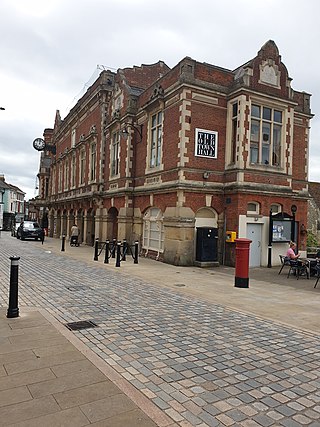
The Old Town Hall is a municipal building in the High Street, Hemel Hempstead, Hertfordshire, England. The town hall, which was the meeting place of Hemel Hempstead Borough Council, is a Grade II listed building.
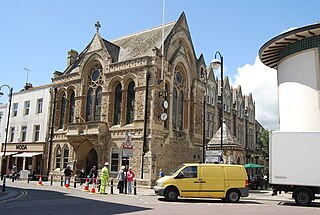
Hastings Town Hall is a municipal building in Queen's Road, Hastings, East Sussex, England. The town hall, which was the meeting place of Hastings Borough Council, is a Grade II listed building.

West Hartlepool Town Hall is an events venue in Raby Road, Hartlepool, County Durham, England. It is a Grade II listed building.

Chippenham Town Hall is a 19th-century municipal building in the High Street, Chippenham, Wiltshire, England. The town hall, which was the headquarters of Chippenham Borough Council, is a Grade II listed building.

Farnham Town Hall is a municipal building in South Street, Farnham, Surrey, England. It provides the offices and the meeting place of Farnham Town Council.

The Municipal Buildings are in Oldbury town centre, West Midlands, England. The structure served as the headquarters of Oldbury Borough Council.
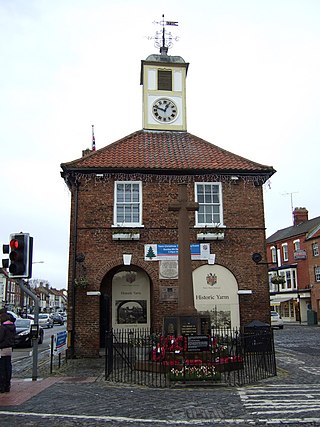
Yarm Town Hall is a municipal building in the High Street in Yarm, North Yorkshire, England. The structure, which is the meeting place of Yarm Town Council, is a Grade II listed building.

The Old Town Hall, sometimes referred to as the Moot Hall, is a municipal building in Church Street, Clitheroe, Lancashire, England. The structure, which was the meeting place of Clitheroe Borough Council, is a Grade II listed building.
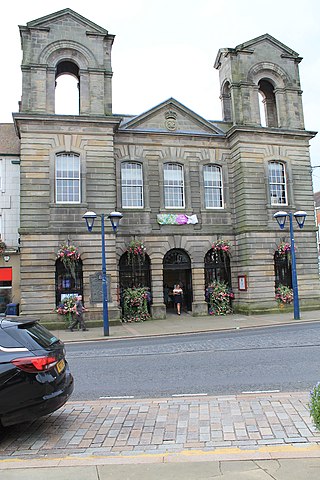
Morpeth Town Hall is a municipal building in the Market Place, Morpeth, Northumberland, England. The structure, which was the meeting place of Morpeth Borough Council, is a Grade II listed building.

The Old Town Hall is a municipal building in the Middlehaven area of Middlesbrough, North Yorkshire, England. The building is on East Street and has been vacant since 1996. It is a Grade II listed building with the adjacent clock tower also separately Grade II listed.

Dalton Town Hall is a municipal building in Station Road, Dalton-in-Furness, a town in Cumbria, England. The building, which accommodates the offices and meeting place of Dalton-in-Furness Town Council, is a Grade II listed building.




















